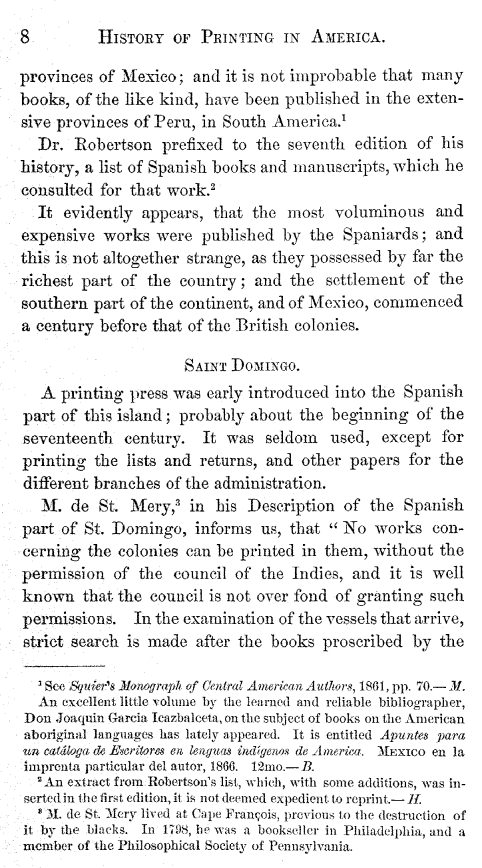
<pb n="8"/> provinces of Mexico; and it is not improbable that many <lb/> books, of the like kind, have been published in the exten- <lb/> sive provinces of Peru, in South America.<ref target="n8.1"><sup>1</sup></ref> <note id="n8.1" place="foot"><seg type="note-symbol"><sup>1</sup></seg><p>See <i>Squier's Monograph of Central American Authors</i>, 1861, pp. 70.—<i>M</i>.</p> <p>An excellent little volume by the learned and reliable bibliographer, <lb/> Don Joaquin Garcia Icazbalceta, on the subject of books on the American <lb/> aboriginal languages has lately appeared. It is entitled <i>Apuntes para <lb/> un cataloga de Escritores en lenguas indmgenos de America</i>. <smcap>Mexico</smcap> en la <lb/> imprenta particular del autor, 1866. 12mo.—<i>B</i>.</p></note> </p> <p>Dr. Robertson prefixed to the seventh edition of his <lb/> history, a list of Spanish books and manuscripts, which he <lb/> consulted for that work.<ref target="n8.2"><sup>2</sup></ref> <note id="n8.2" place="foot"><seg type="note-symbol"><sup>2</sup></seg><p>An extract from Robertson's list, which, with some additions, was in- <lb/> serted in the first edition, it is not deemed expedient to reprint.—<i>H</i>.</p></note> </p> <p>It evidently appears, that the most voluminous and <lb/> expensive works were published by the Spaniards; and <lb/> this is not altogether strange, as they possessed by far the <lb/> richest part of the country; and the settlement of the <lb/> southern part of the continent, and of Mexico, commenced <lb/> a century before that of the British colonies.</p> </div3> <div3 type="section"> <head><smcap>Saint Domingo</smcap>.</head> <p>A printing press was early introduced into the Spanish <lb/> part of this island; probably about the beginning of the <lb/> seventeenth century. It was seldom used, except for <lb/> printing the lists and returns, and other papers for the <lb/> different branches of the administration.</p> <p>M. de St. Mery,<ref target="n8.3"><sup>3</sup></ref> <note id="n8.3" place="foot"><seg type="note-symbol"><sup>3</sup></seg><p>M. de St. Mery lived at Cape François, previous to the destruction of <lb/> it by the blacks. In 1798, he was a bookseller in Philadelphia, and a <lb/> member of the Philosophical Society of Pennsylvania.</p></note> in his Description of the Spanish <lb/> part of St. Domingo, informs us, that "No works con- <lb/> cerning the colonies can be printed in them, without the <lb/> permission of the council of the Indies, and it is well <lb/> known that the council is not over fond of granting such <lb/> permissions. In the examination of the vessels that arrive, <lb/> strict search is made after the books proscribed by the <lb/>